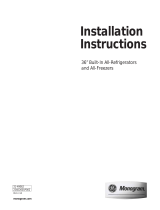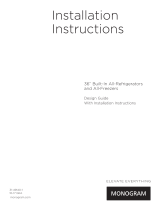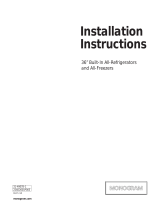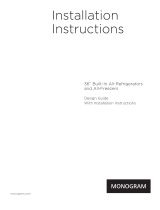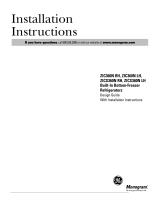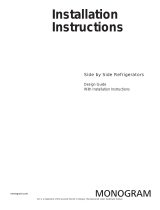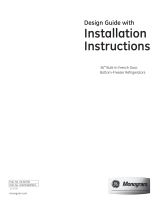Page is loading ...

Design Guide with
Installation
Instructions
36” Built-In Bottom-Freezer
Refrigerators
monogram.com
31-49063
224D3095P002
09-14 GE

Safety Information
2
BEFORE YOU BEGIN
Read these instructions completely and carefully.
• IMPORTANT – Save these instructions for
local inspector’s use. Observe all governing codes
and ordinances.
• Note to Installer – Be sure to leave these
instructions with the Consumer.
• Note to Consumer – Keep these instructions with
your Owner’s Manual for future reference.
If you received a damaged refrigerator, you should
immediately contact your dealer or builder.
Skill Level – Installation of this refrigerator requires
basic mechanical, carpentry and plumbing skills.
Proper installation is the responsibility of the installer.
Product failure due to improper installation is not
covered under the GE Appliance Warranty.
See the Owner’s Manual for warranty information.
WARNING Electrical Shock Hazard.
Plug into a grounded 3-prong outlet.
Do not remove the ground prong.
Do not use an adapter.
Immediately replace electric cords that become frayed
or damaged.
Do not use an extension cord with this appliance.
Failure to follow these instructions can result in death,
fire, or electrical shock.
Follow the instructions in the section Grounding the
Refrigerator.
This is the safety alert symbol. This symbol alerts you to potential hazards that can kill or hurt you and others.
All safety messages will follow the safety alert symbol and the word “DANGER”, “WARNING”, or “CAUTION”. These
words are defined as:
DANGER Indicates a hazardous situation which, if not avoided, will result in death or serious injury.
WARNING Indicates a hazardous situation which, if not avoided, could result in death or serious injury.
CAUTION Indicates a hazardous situation which, if not avoided, could result in minor or moderate injury.
For Monogram local service in your area, call 1.800.444.1845.
For Monogram service in Canada, call 1.800.561.3344
For Monogram Parts and Accessories, call 1.800.626.2002.
www.monogram.com
WARNING Tip Over Hazard.
These refrigerators are top heavy, especially with any doors open, and must be secured to prevent tipping
forward which could result in death or serious injury. Read and follow the entire installation instructions for
securing the refrigerator with the anti-tip system.
WARNING Explosion Hazard.
Keep flammable materials and vapors, such as gasoline, away from refrigerator. Failure to do so can result in
fire, explosion, or death.
WARNING To reduce the risk associated with choking, do not allow children under 3 years of age to have
access to small parts during the installation of this product.
CAUTION Lifting Hazard
This refrigerator is very heavy. To reduce the risk of person injury during maneuvering and installing this
refrigerator, 3 people are required for proper installation.

Contents
4
Safety 2-3
Planning Guide
The Installation Space 5
Dimensions and Clearances 5
Customization Basics 6
3/4” Overlay Panel Dimensions - Flush 6
1/4” Framed Panel Dimensions - Standard 7
3/4” Overlay Panel Dimensions - Standard 7
130° Door Swing 8
90° Door Swing 9
Side Panels 10
ZUG2 Grille Panel Dimensions 10
Installation Instructions
Tools, Hardware, Materials 11
Grounding the Refrigerator 11
Parts Identification 12-13
Step 1. Remove Packaging 14
Step 2. Install Water Line 14-15
Step 3. Install Side Panels 15
Step 4. Install Case Trim 15
Step 5. Anti-Tip Procedures 15-17
Step 6. Level Refrigerator 17
Step 7. Secure Refrigerator to Cabinetry - Flush Install 18
Step 8. Secure Unit to Wall - Standard Install 18
Step 9. Alternate Anti-Tip Procedure 18
Step 10. Adjust Door Swing 18
Step 11. Remove Door Trim 19
Step 12. Layout Decorative Door Panels 20-21
Step 13. Attach Brackets to Panels 21
Step 14. Attach Brackets to Freezer Door Panel 22
Step 15. Hang Decorative Door Panels 22
Step 16. Layout Decorative Grille Panel 23
Step 17. Install Grille Panel 23
Step 18. Adjust Decorative Panels 24-25
Step 19. Replace Trim 25
Step 20. Connect Water Supply 26
Step 21. Connect Power 26
Step 22. Start Icemaker 26
Step 23. Install Toekick 26

36" Frame to
Frame Width
*84" From
Floor to
Top Frame
35"
Case Width
*83-1/2"
at
Rear
25-3/8" Framed Models
25-3/4" Stainless Steel Models
Case Depth
Depth Including Handles:
26-7/8" Framed Models
27-3/4" Stainless Steel Models
28-11/16" Professional Style Models
THE INSTALLATION SPACE
Water And Electrical Locations
Electrical and water supply must be located as shown.
The cutout depth must be 24”
The refrigerator will project forward, slightly beyond
adjacent cabinetry, depending on your installation.
Allow minimum 1/8” air gap between case back & wall.
Cutout depth beneath a soffit:
When installed beneath a soffit, the soffit cannot exceed
the 24” installation depth shown. The top case trim
overlaps the bottom of the soffit.
Additional Specifications
• A 115 volt 60Hz., 15 or 20 amp power supply is required.
An individual properly grounded branch circuit or circuit
breaker is recommended. Install
a properly grounded 3-prong electrical receptacle
recessed into the back wall. Electrical must be located
on rear wall as shown.
Note: GFI (ground fault interrupter) is not recommended.
• Water line can enter the opening through the floor
or back wall. Route GE SmartConnect™ kit or 1/4” O.D.
copper tubing between the cold water line and the
water connection location. The tubing should be
long enough to extend to the front of the refrigerator.
Installation of an easily accessible shut-off valve in the
water line is required.
DIMENSIONS AND CLEARANCES
* Shipping height. The
refrigerator can be
adjusted to fit into a
cutout that is 84-1/2”
max. height. Note that
the top case trim at
the front is 1/2” higher
and will overlap upper
cabinetry or soffit. Use
leveling legs and wheels
for a maximum 1” height
adjustment.
Product Clearances
These refrigerators are equipped with a 3-position door
stop. The factory set 115° door swing can be adjusted to
90° if clearance to adjacent cabinets or walls is restricted.
5
6"
Wall View
Electrical
Area
84-1/2" max
Finished
Opening
75" From
Floor to
Bottom
of Electrical Area
10"
24" Cutout Depth
35-1/2"
Finished Width
2-5/16"
5"
10"
10"
3-1/2" 3-1/2"
5"
3-1/2"
Water Supply
ZUG2, ZUGSS2 Unified Grille Panel Kit
• If you are installing two refrigerators, side by side,
the installation space must be 71-1/2” wide.
Note: Additional cutout width may be required when side panels
are used. Add side panel thickness to the finished cutout to
calculate rough-in width.
• The water and electrical locations for each product must
be located as shown.
• A separate 115V, 60Hz., 15 or 20 amp power supply is
recommended for each product.
Allow 25” minimum clearance for
a full 130° door swing. Allow 15”
for pan removal.
For a 90° door swing, allow
4” min. clearance to a wall,
for framed and stainless steel
models. Allow 5” min. clearance
for professional style models. If
the 90° door stop position is used,
pan access is maintained, but pan
removal is restricted.
See illustrations pages 4 and 5 to determine door swing
interaction with adjacent cabinets or countertops.
Design Guide
*For standard installation, the finished cutout width
must be 35-1/2”.
*For flush mount installation, the finished cutout width
must be 39”.
115° Door Swing

CUSTOMIZATION BASICS:
Framed Or Overlay Panels, Custom
Handles and Accessory Kits
Professional Style Stainless Steel Refrigerators
Stainless steel wrapped refrigerators with beveled edges
and professional style handles. These models are shipped
ready for installation.
Stainless Steel Wrapped Refrigerators
Stainless steel wrapped refrigerators with beveled edges
and tubular stainless steel handles that coordinate with
other Monogram appliances. These models are shipped
ready for installation.
Trimmed Refrigerators
Trimmed refrigerators are designed to be customized
with decorative panels. Field installed custom door and
grille panels are required.
Side Panels
Side panels must be used whenever the sides of the
refrigerator will be exposed.
6
Optional Accessory Kits
• ZKHCSS2: Monogram Tubular Stainless Steel handles
designed to fit 3/4” overlay panels. This kit also includes a
handle side trim for custom handles.
• ZKHPSS1: Professional Tubular Stainless Steel Handle
designed to fit 3/4” overlay panels. Kit includes one
handle. Order 2 kits for bottom-freezer refrigerators from
your Monogram supplier.
• ZUG2: For side-by-side installation of two trimmed
bottom-freezer refrigerators. This kit provides for the
installation of a unified custom grille panel to span the
width of two units using a framed or overlay panel.
• ZUGPP2: For side-by-side installation of two professional-
style bottom-freezer refrigerators. This kit provides a
unified stainless steel grille panel to span the width of two
units.
• ZUGSS2: For side-by-side installation of two stainless steel
wrapped bottom-freezer refrigerators. This kit provides a
unified stainless steel grille panel to span the width of two
units.
• ZKHCT: Handle side trim for left-hand and right-hand
doors. For use on 3/4” custom panels when using a
custom handle.
• ZTK36BFRHH: Trim kit for standard installation using
custom panels. This kit is for use with a right hand door
swing.
• ZTK36BFLHH: Trim kit for standard installation using
custom panels. This kit is for use with a left hand door
swing.
Design Guide
3/4” OVERLAY PANEL DIMENSIONS
(Flush Installation Only)
For a more custom appearance, overlay panels may be
installed to give a flush appearance with surrounding
cabinets. The overlay panel must be 3/4” thick. Panel
attaches to included brackets to provide mounting to the
appliance door.
IMPORTANT NOTE: Maximum total weight for the assembled panels:
Door panel – 67 lbs. Grille Panel – 18 lbs.
1/2”
1/2”
1-1/4” 1”
1-1/4” 1”
Top/Bottom Hinge
Clearance
Router 1/8” Deep
Grille Panel
Fresh Food
Panel
38"
9-5/8"
Freezer Drawer
Panel 22-5/16"
46-1/2"
CUSTOM HANDLE DESIGN GUIDE
(Flush Installation Only)
For custom handle installation, counterbore holes in rear
of decorative panels may not exceed 1/4” depth to ensure
1/2” material thickness remains for handle support.
NOTE: The counterbore
must not exceed 1” in
diameter.
Minimum distance from handle
side edge to handle center on
the fresh food door should be
2-1/2” as shown.
Minimum distance from top
edge to handle center on the
freezer drawer should be 1-1/2”
as shown.
1/4”
1/2”
3/4”
2-1/2”
1-1/2”
Improper installation can lead to a finger pinch
point hazard between the side door trim and the
cabinets when operating the door, especially
with children. To minimize this risk you must
follow the installation instructions for cabinet
dimensions, trim assembly, and door stop angle.
Door Trim Pinch Point Hazard
WARNING

1/4” FRAMED PANEL DIMENSIONS
(Standard Installation Only)
7
If you choose to install framed panels, they must be cut
to the dimensions shown. The panels will slide into the
frame on the door, drawer and grille.
If the custom panel is less than 1/4” thick and if it fits
loosely in the door frame, it can be backed up with a
piece of filler material or foam tape to improve the fit.
3/4” OVERLAY PANEL DIMENSIONS
(Standard Installation Only)
For a more custom appearance, overlay panels may be installed
on trimmed models. The overlay panel must be secured to a
1/4” thick backer panel which slides into the trim. A spacer
panel 0.10” thick must be placed between the overlay and
backer panel.
Assemble the panels with glue and screws.
• Center the spacer panel on the backer panel, left to right and
top to bottom. Secure the panels with glue.
• Center the spacer and backer panel on the overlay panel and
secure with glue and screws. Screws must
be countersunk into the backer panel.
Spacer Panel
Backer Panel
Overlay Panel
Framed Panel Dimensions
A (Width) B (Grille Height) C (FF Height) D (FZ Height)
1/4” Framed Panel 33-7/8” 8-7/8” 46-1/16” 21-7/8”
Overlay Panel Dimensions
A (Width) B (Grille Height) C (FF Height) D (FZ Height)
1/4” Backer Panel 33-7/8” 8-7/8” 46-1/16” 21-7/8”
0.10” Spacer Panel 32-1/2” 7-5/8” 44-11/16” 20-1/2”
3/4” Overlay Panel 34-1/8” 9” 46-5/16” 22”
NOTE: Left-to-right offset is not always equal to
top-to-bottom offset.
1/4"
Panel
Door
5/16"
Trim
Reveal
IMPORTANT NOTE: Maximum total
panel weight:
• Fresh food door panel – 58 lbs.
• Freezer drawer panel – 28 lbs.
• Grille Panel – 11 lbs.
IMPORTANT NOTE: Maximum
total weight for the assembled
panels:
• Fresh food door panel – 58 lbs.
• Freezer drawer panel – 28 lbs.
• Grille Panel – 11 lbs.
Design Guide

1/4" 1/2" 3/4" 1" 1-1/4"
1"
3/4" Overlay
Panel
(Nominal Size)
Stainless Steel
1/4"
1/2"
3/4"
2"
1-1/4"
1-1/2"
1-3/4"
3"
2-1/4"
2-1/2"
2-3/4"
1/4"
1/2"
3/4"
Door
23-7/8" From
Rear of
Refrigerator
1"
Refrigerator
Case
Trim
Top View
130° DOOR SWING
(Standard Installation
Only)
Scale 1:1
8
Frameless Cabinets: The case trim
overlaps cabinets at the top and sides.
Therefore, frameless cabinets
may require filler strips to prevent
interference with cabinet door swing.
The opening must allow for filler strips.
Design Guide

1/4"
1/2"
3/4"
1"
1-1/4"
1/4"
1/2"
3/4"
1"
1-1/4"
1-1/2"
23-7/8"
From Rear of
Refrigerator
3/4" Overlay
Panel
(Nominal Size)
Case Trim
Refrigerator
Door
Stainless Steel
9
Top View
90° DOOR SWING
(Standard
Installation Only)
Scale 1:1
Frameless Cabinets:
The case trim overlaps
cabinets at the top and
sides. Therefore, frameless
cabinets may require
filler strips to prevent
interference with cabinet
door swing. The opening
must allow for filler strips.
Design Guide

*84"
2-9/16"
24"
*3" to 4"
3/16"
1-7/8"
Design Guide
10
SIDE PANELS
Side panels must be used whenever the sides of the
refrigerator will be exposed. The 1/4” side panels will
slip into the side case trim. Secure the panels to the
refrigerator with stick-on hook and loop fastener strips.
Order the side panels from the cabinet manufacturer.
• Cut a notch in the top front corner as shown to allow
clearance for corner keys in the front side trim.
ZUG2 GRILLE PANEL DIMENSIONS
The ZUG2 unified grille panel kit provides for the
installation of a framed or overlay grille panel.
* Depending on
installation height.
Assemble the overlay panels in the same manner as
the door and drawer panels.
Framed Panel Dimensions
A (Width) B (Height)
1/4” Framed Panel 69-7/8” 8-7/8”
Overlay Panel Dimensions
A (Width) B (Height)
1/4” Backer Panel 69-7/8” 8-7/8”
0.10” Spacer Panel 68-1/2” 7-5/8”
3/4” Overlay Panel 70-1/8” 9”

11
MATERIALS REQUIRED
• 35” long 2x4 for Anti-Tip support
• 1/4” copper water line tubing or GE SmartConnect™
Refrigerator Tubing kits
• Water shut-off valve
• Custom panels for fresh food door, freezer drawer
and grille panel
• Screws to secure refrigerator to cabinetry.
• Stick-on hook and loop fastener strips for
1/4” side panels
FLOORING
For proper installation, this refrigerator must be placed
on a level surface of hard material that is at the same
height as the rest of the flooring. This surface should
be strong enough to support a fully loaded refrigerator,
or approximately 1,200 lbs.
NOTE: Protect the finish of the flooring. Cut a large
section of the cardboard carton and place under the
refrigerator where you are working.
TOOLS REQUIRED
• Tinsnips to cut banding
• Stepladder
• Bucket
• Level
• Appliance Hand Truck
• Tubing cutter
• 7/16” open-end wrench
• #2 Phillips screwdriver
• Drill and appropriate bits
• 5/16”, 7/16” socket
• Safety glasses
• 1-1/4” open end wrench
• Pliers
• 1/4” ratchet
HARDWARE SUPPLIED
• Water filter bypass plug
• Anti-Tip brackets
• 1/4” nut and ferrule
• Flush inset bracket pack
• Case trim(s)
Installation Instructions
GROUNDING THE REFRIGERATOR
WARNING Electrical Shock Hazard.
Failure to follow these instructions can result in death,
fire, or electrical shock.
The power cord of this appliance is equipped
with a 3-prong (grounding) plug which mates
with a standard 3-prong (grounding) wall receptacle
to minimize the possibility of electric shock hazard from
this appliance.
Have the wall outlet and circuit checked by
a qualified electrician to make sure the outlet
is properly grounded.
Where a standard 2-prong wall outlet is encountered, it
is your personal responsibility and obligation
to have it replaced with a properly grounded
3-prong wall outlet.
DO NOT, UNDER
ANY CIRCUMSTANCES,
CUT OR REMOVE
THE THIRD (GROUND) PRONG
FROM THE POWER CORD.
DO NOT USE AN ADAPTER PLUG TO CONNECT
THE REFRIGERATOR TO A 2-PRONG OUTLET.
DO NOT USE AN EXTENSION CORD WITH THIS
APPLIANCE.
MISE À LA TERRE DU RÉFRIGÉRATEUR
AVERTISSEMENT
Risque de choc électrique.
Le non-respect de ces instructions peut entraîner des
risques d’incendies, des chocs électriques ou la mort.
Le cordon d’alimentation de cet appareil est équipé
d’une fiche à trois broches (pour une mise à la terre)
qui s’adapte à la prise de courant standard à 3
broches (pour une mise à la terre) pour minimiser les
risques de chocs électriques par cet appareil.
Faites vérifier la prise murale et le circuit électrique par
un électricien qualifié pour s’assurer que le système est
correctement mis à la terre.
Dans le cas d’une prise biphasée, l’installateur a la
responsabilité et l’obligation de la remplacer par une
prise triphasée correctement mise à la terre.
NE COUPEZ PAS OU N’ENLEVEZ
PAS, SOUS AUCUN PRÉTEXTE,
LA TROISIÈME BROCHE DE
MISE À LA TERRE DU CORDON
D’ALIMENTATION.
N’UTILISEZ PAS D’ADAPTATEUR
POUR BRANCHER LE
RÉFRIGÉRATEUR À UNE PRISE BIPHASÉE.
N’UTILISEZ PAS DE RALLONGE AVEC CET APPAREIL.

PARTS IDENTIFICATION:
12
Installation Instruction
Panel Bracket, Top Right
RH Door
Panel Bracket, Bottom
Right
RH Door
Panel Bracket, Bottom Left
LH Door
Panel Bracket, Top Left
LH Door
Panel Bracket, Top
Panel Bracket, Bottom
(5)
Door Bracket (8);
Installed on door and
drawer
TOP IF HINGES ARE ON THE LEFT
TOP IF HINGES ARE ON THE RIGHT
BOTTOM IF HINGES ARE ON THE RIGHT
BOTTOM IF HINGES ARE ON THE LEFT
Fresh Food Door Panel
Template
Grille Panel Template
Freezer Door Panel
Template
Door Trim Top
Door Trim, Bottom
Freezer Drawer Bracket Rt
Freezer Drawer Bracket Lt
Freezer Drawer Trim Rt
Freezer Drawer Trim Lt
Freezer Drawer Visor
Freezer Drawer Top Cover

Fresh Food Door
Trim, Handle Side
Visor
Fresh Food Door
Trim, Handle Side
Cover
Trim, Case, RH Side
Trim, Case, LH Side
PARTS IDENTIFICATION:
13
Installation Instruction

STEP 2 INSTALL WATER LINE
• A cold water supply is required for automatic
icemaker operation. The water pressure must be
between 40 and 120 p.s.i.
• Route 1/4” OD copper or GE SmartConnect™ plastic
tubing between house cold water line and the water
connection location.
• Tubing should be long enough to extend to the front of
the refrigerator. Allow enough tubing to accommodate
bend leading into the water line connection.
NOTE: The only GE-approved plastic tubing is supplied
in the GE SmartConnect™ Refrigerator Tubing kits. Do not
use any other plastic water supply line because the line
is under pressure at all times. Other types of plastic may
crack or rupture with age and cause water damage to
your home.
GE SmartConnect™ Refrigerator Tubing Kits are available
in the following lengths:
2’ (.6 m) WX08X10002
6’ (1.8 m) WX08X10006
15’ (4.6 m) WX08X1 0015
25’ (7.6 m) WX08X10025
Shut off the main water supply.
Turn on the nearest faucet long enough to clear the line
of water.
• Install a shut-off valve between the icemaker water
valve and cold water pipe in a basement or cabinet.
The shut-off valve should be located where it will be
easily accessible.
14
Floor
Waterline Tubing
Installation Instructions
• Turn on the main water supply and flush debris.
Run about a quart of water through the tubing into
a bucket. Shut off water supply at the shut-off valve.
NOTE: Saddle type shut-off valves are included in
many water supply kits, but are not recommended
for this application.
NOTE: Commonwealth of Massachusetts Plumbing
Codes 248CMR shall be adhered to. Saddle valves
are illegal and use is not permitted in Massachusetts.
Consult with your licensed plumber.
STEP 1 REMOVE PACKAGING
WARNING Tip Over Hazard.
The refrigerator is much heavier at the top than at the
ERWWRP³EHFDUHIXOZKHQPRYLQJ:KHQXVLQJDKDQG
truck, handle from the side only.
AVERTISSEMENT
Risque de basculement
Le réfrigérateur est beaucoup plus lourd en haut qu’en
bas. Il faut être prudent lors des déplacements. Si un
diable est utilisé, il faut soulever le réfrigérateur sur le côté
seulement.
• Carefully cut banding at the top and bottom, remove the
outer carton.
• Slide out the back corner posts (2).
• Slide the carton off the top of the cabinet.
NOTE: IT IS NOT NECESSARY TO LAY THE CABINET DOWN
IN ORDER TO REMOVE THE SKID!
• The unit is secured to the
skid with 4 slotted tie-down
straps. Remove the six 7/16”
bolts from the base channels
in the tie-downs.
• Remove the six 7/16” bolts
securing the straps to the
skid.
NOTE: DO NOT ATTEMPT TO
ROLL UNIT OFF SKID.
• The support blocks on the
bottom of the refrigeration
case must be removed
before the refrigerator is
taken off the skid or damage will occur. Carefully tilt the
refrigerator and slide the blocks out from beneath.
• Remove the toekick and set aside for final installation.
• Lift the refrigerator off the skid with an appliance dolly.
Handle from the sides.
Remove 2 strap
bolts on each side
Remove 5
base channel
bolts on each
side

15
STEP 2A
WATER LINE INSTALLATION WITH
A REVERSE OSMOSIS SYSTEM
Skip this step when not using an RO System
If the water supply to the refrigerator is from a Reverse
Osmosis Water System, use the refrigerator’s filter bypass
plug. Using the refrigerator’s water filtration cartridge with
the RO filter can result in hollow ice cubes.
STEP 3
INSTALL SIDE PANELS
Skip this step when not using side panels
If you are using 1/4
”
side panels, they should be inserted
into the case trim. Fasten the panels to the refrigerator
with stick-on hook and loop fastener strips before setting
refrigerator in place.
Filter Bypass Plug
Installation Instructions
STEP 4 INSTALL CASE TRIM
Install case trim using supplied right hand and left hand
case trim pieces and case trim screws. Attach case trim
to each side of case as shown in illustration using case
trim screws in holes provided down each side of case.
STEP 5
ANIT-TIP PROCEDURE
WARNING Tip Over Hazard.
These refrigerators are top heavy, especially
with any doors open, and must be secured to
prevent tipping forward which could result in
death or serious injury. Read and follow the
entire installation instructions for securing the
refrigerator with the anti-tip system.
AVERTISSEMENT Risque de
basculement
Ces réfrigérateurs présentent une partie
supérieure lourde, en particulier avec une porte
ouverte; ils doivent donc être fixés pour prévenir le
basculement vers l’avant et le risque concomitant
de blessure grave ou fatale. Lisez et suivez
les instructions d’installation complètes pour
l’installation du système anti-basculement.
Flush Installation Only
• Cut a 1/2” x 4” block, 35” long.
• Measure and mark under the soffit, 5-1/4” from the
front edge of the cabinet.
• Secure the wood block to under the soffit. From
the bottom of the block to the finished floor should
measure 84”. See the illustration.

16
Installation Instructions
STEP 5
ANIT-TIP PROCEDURE
(CONT)
Standard Installation Only
• The kit supplied with the unit contains 2 lag bolts and 4
toggles with bolts. The wall bracket will be attached to
the wall in 4 places.
• Measure the opening where the unit is to be installed.
Mark the center with a vertical line.
• Measure up 81 1/2” from the floor. Mark this point on the
wall.
• Using a level, draw a horizontal line on the wall at this
height.
• Locate at least 2 studs on the back wall. Mark these
points on the horizontal line.
• Place the bottom of the wall bracket with tabs on the
horizontal line. Align the center notch on the bracket
with the center line on the wall.
• The anti-tip wall bracket has a series of holes. Select 2
holes that match with the located studs. Make sure the
holes selected are on the center of the studs. Mark the
wall at these points.
• Mark an additional hole at each end of the bracket. If
one of the studs is closer to the end of the bracket, mark
an additional hole towards the center of the bracket.
• Drill 1/2” holes into the wall board at the locations
marked for the toggles to be mounted (not the stud
markings).
• Drill 3/16” holes into wooden studs where marked. If
steel stud construction, drill 1/2” holes into the studs
where marked. You will use 2 toggles with the metal
studs.
Install Wall Toggles:
The wall toggles and bolts can be ordered as Service Kit
#WR49X10193. Wall toggles are installed in the drywall
and metal studs for stability. Install the wall toggles as
follows:
• Drill 1/2” holes at the wall markings made in the holes at
the ends of the wall bracket.
• Hold the metal channel flat against the plastic straps
and slide the channel through the hole.
• Gently pull back at the ends of the plastic straps to make
the channel rest flush behind the wall.
• Hold the ends of the straps in one hand and slide the
plastic cap along the straps until the flange of the cap is
flush with the wall.
Line on Wall
Center
Two Additional
Hole Locations at
Ends of Brackets
Center Wall Bracket
Line On Wall
Wall Studs
Plastic Straps
Metal Channel
Cap

STEP 6 LEVEL REFRIGERATOR
All models have 4-point leveling. The front is supported
by leveling legs, the rear is supported by adjustable
wheels. Both are accessible from the front of the
refrigerator.
• To level the back of the refrigerator, turn the 7/16” hex
nut located above the front wheels. Turn clockwise to
raise or counterclockwise to lower the refrigerator.
• For front leveling, use a 1-1/4” open-end wrench.
• Adjust height of refrigerator to match installation
cutout opening 83-1/2 to 84-1/2”. The refrigerator
should be level and plumb with cabinetry.
NOTE (Flush Installation Only): Raise refrigerator until
the case top comes in contact with the 1/2” spacer
block mounted to the underside of the cabinet soffit.
Refrigerator should be level at fully raised position.
ATTENTION
Les roues de nivellement arrière et les pattes de
nivellement avant permettent un réglage maximal
de 25 mm (1 po). Si l’ouverture pour le réfrigérateur
a une hauteur supérieure à 2,15 m (84-1/2 po),
l’installateur doit élever le réfrigérateur sur une feuille
de contre-plaqué ou des glissières. Il est également
possible d’ajouter des baguettes de finition des
placards sur le haut de l’ouverture afin de la réduire.
Lever le réfrigérateur de plus de 25 mm (1 po)
endommage les pattes de nivellement avant
et les roues de nivellement arrière.
CAUTION
The rear leveling wheels and front leveling legs are
limited to a maximum height adjustment of 1”. If the
installation requires more than 84-1/2” height, the
installer should elevate the refrigerator on a sheet
of plywood or runners. Cabinetry trim could also be
added across the top of the opening to shorten the
opening. If you attempt to raise the refrigerator more
than 1”, you will damage the front leveling legs and the
rear leveling wheels.
Installation Instructions
STEP 5
ANIT-TIP PROCEDURE
(CONT)
Standard Installation Only (Cont)
• Place your thumb between the plastic straps and bend
up and down to snap the straps off at the wall.
Install Screws and Bolts:
• Have someone hold the wall bracket centered in place
with each of the holes aligned with the correct opening
in the bracket and level with the horizontal line.
• Insert the lag screws through the bracket and into the
stud. Tighten with a wrench.
• Insert the bolts into the toggle by hand until snug.
Tighten with a wrench.
CONNECT POWER CORD:
• Before pushing the refrigerator into the opening, plug
the power cord into the receptacle. Open the grille panel
and reach into the opening at the back to grasp the
power cord. Pull the power cord into the opening as you
push the refrigerator back.
• Gently push refrigerator into the opening with hands
against front corners.
IMPORTANT NOTE FOR STANDARD INSTALLATION: When
the refrigerator is installed under a soffit or if there is
not enough height for this method of security, brackets
cannot be used. Proceed to step 6 to level the refrigerator
and then to step 8 to secure refrigerator to cabinets. See
step 9 if you have metal wall studs. The refrigerator must
be secured to prevent tipping.
Wood Stud
Lag Screw
Anti-Tip Wall Bracket
Anti-Tip Wall Bracket
Bolt
Wall Toggle
Drywall or
Steel Stud

STEP 8 SECURE UNIT TO WALL -
STANDARD INSTALLATION
ONLY
• The “L” rod can be found in the upper left corner of
the unit in the access compartment. Look through the
access compartment to make sure the rod lines up
with the anti-tip bracket.
• There are 2 washers and a hair pin cotter with the rod.
Remove the washers and hair pin cotter from the end
of the rod.
• Rotate and move the
“L” rod into the slot in
the anti-tip bracket tab.
Once it is in the slot,
rotate the “L” rod so the
hook portion is pointing
down. The holes at the
front end of the rod
should be in a vertical
position.
• Pull out on the end of
the rod to make sure it is secure in the bracket.
• Locate the hole on the rod that is closest to the unit. A
hair pin cotter will be put through this hole to secure
the rod. If this hole appears to be too far away for a
snug fit against the unit, add the washers one at a time
until the pin will fit tightly into the hole.
• Align the straight section of the pin with the hole from
the underside of the rod. Push the pin up until it snaps
into position. Pliers may be used. NOTE: The hair pin
cotter must be vertical when this step is completed to
ensure the “L” rod is engaged in the bracket.
STEP 8 SECURE UNIT TO WALL -
STANDARD INSTALLATION
ONLY
• Check the rod for
tightness by pulling
forward. If the rod
moves, remove the hair
pin cotter and place
another washer on the
rod. Reinsert the pin.
18
Installation Instructions
Drive Screws
Through Case Trim and Into
Adjacent Cabinets
STEP 7 SECURE REFRIGERATOR
TO CABINETRY - FLUSH
INSTALLATION ONLY
The refrigerator must be secured to prevent tipping.
• Drill hole in trim and drive screw through the trim into
adjacent cabinet.
• Follow the same procedure on the opposite side.
• Drill a hole in the case top and drive a screw through
the top into the adjacent 1/2” block.
STEP 9 ALTERNATE ANTI-TIP
PROCEDURE
The refrigerator must be secured to prevent tipping.
The anti-tip brackets cannot be used on metal wall
studs. Use this Alternate Procedure to secure the
refrigerator against tip-over whenever metal wall
studs are encountered and there is no soffit.
• Raise the grille panel to access case trim.
• Use a 3/16” bit to drill four evenly spaced clearance
holes through the metal top case trim.
• Use a 1/16” bit to drill to pilot holes through the metal
clearance holes and into the wood soffit. The holes
should be centered in the soffit or a 3/4” min. wood
brace. The brace spanning the enclosure must be
securely fastened to cabinets on both sides.
• Install four, 1-1/2” drywall screws into the pilot holes.

STEP 10 ADJUST DOOR SWING
NOTE: This refrigerator has a 3-position door stop.
When space does not allow the door to swing open
fully to 115°, you may change the door swing to a 90°
opening. A 130° door swing is available for standard
installation only. If used for flush installation, damage
will occur to wood panels. Skip this step if door
opening is satisfactory for your installation situation.
• Lift the grille panel to access the wire cover trim.
• Remove screws on both sides of the wire cover trim
and rotate off.
• Use pliers to unscrew door stop and reinstall into the
90° or 130° (standard only) position.
• Reinstall the wire cover trim.
Remove
Wire Cover
Trim Screws
Pin Location
for 90°
Door Swing Pin Location for
130° Door Swing
(Standard Only)
Pin Location
as Shipped
for 115°
Door Swing
19
Installation Instructions
STEP 11 REMOVE DOOR TRIM -
FLUSH
INSTALLATION ONLY
Use the supplied Torx wrench or T10 Torx head driver to
remove all exposed trim screws securing aluminum trim to
refrigerator doors. Save all trim and screws as they will be
replaced in a later step.
1. Remove 4 screws and trim from the hinge side of the door.
2. Remove 4 trim screws on vertical handle side of the door to
release handle cover trim. Remove the handle cover trim to
expose handle visor trim underneath.
3 Remove 4 additional trim screws from handle visor trim.
Once screws have been removed, remove handle visor
trim.
4. Remove 2 screws and trim from each side of the drawer.
These screws are longer than the other trim screws. Make
sure these are used when reinstalling side trim to drawer.
Hinge Side
Door Trim
Top Drawer
Cover
Top
Drawer
Visor
Drawer
Side Trim
Drawer Side
Brackets
Handle
Cover Trim Handle
Visor Trim
5. Remove 1 screw and side brackets from each side of the
drawer.
6. Remove screws and drawer cover from top of the drawer.
7. Remove screws and visor from top of the drawer.
STEP 12 REMOVE DOOR TRIM -
FLUSH
INSTALLATION ONLY (Cont)

20
Installation Instructions
STEP 12 LAYOUT DECORATIVE DOOR PANELS -
FLUSH INSTALLATION ONLY
Decorative wood panels must be cut to a thickness of
3/4”. The dimensions of each panel can be determined by
referring to the specs provided with refrigerator. Panels
must be predrilled to prevent accidental splitting or
cracking of wood when attaching to door brackets in the
next step.
1. Cut Freezer Drawer and Fresh Food Door panels to
specified dimensions (as noted on page 11 under Design
Guide).
2. Lay the Freezer and Fresh Food panels face down on a
non-scratch surface.
3. Mark a vertical centerline on the backside of the Freezer
and Fresh Food panels.
4. Lay supplied Fresh Food Door panel TEMPLATE (attached
to side case of refrigerator) on the back of the Fresh
Food panel with the lettering face up. See illustration to
ensure proper template has been selected. Make sure
the notch at the top is on the side opposite the hinges
(since this is the BACK of the panel). Align the top, side,
and centerline of the template with the top, side and
centerline of the door. Tape the template to the panel
using masking tape to temporarily secure it in place.
5. Repeat previous step on the Freezer Drawer panel using
the Freezer Drawer panel template.
6. Using a 1/8” wood drill bit, drill pilot holes 1/4” deep
through only the top group of holes in the Fresh Food
Door panel template. Drill all four sets of holes into the
upper and lower corners of the Freezer Drawer panel.
7. Using a pencil, trace the outline of the notch out of the
template at the top corner of the Fresh Food door. This
mark will provide a guide for routing wood to provide
relief for door hinge at top of door panel.
8. Remove the tape from each panel. Slide the Fresh Food
door template to the bottom of the door panel aligning
the bottom, sides, and centerline of the panel with the
bottom, sides and centerline of the templates. Tape in
place.
9. Using a 1/8” wood drill bit, drill pilot holes into the door
panels 1/4” deep through only the bottom group of
holes in the Fresh Food Door panel template. Four
holes will be drilled into the bottom corners of each
door.
Panel is face down
on a non-scratch
surface. You will be
drilling on the BACK
of the panel.
Template is aligned
with top of Fresh
Food panel.
The hinge in this example
is on the right hand side
so the notch is on the left
on the back of the panel.

21
Installation Instructions
STEP 12 LAYOUT DECORATIVE DOOR PANELS -
FLUSH INSTALLATION ONLY
(Cont.)
10. Using a pencil, trace the outline of the notch out of the
template at the bottom corner of each door. This mark
will provide a guide for routing wood to provide relief for
door hinge at bottom of door panel.
11. Route out the traced areas on the rear of each panel
1/4” deep and discard the door panel templates.
Preparation for handles
1. Lay out the location of the custom handle on the back
of the Fresh Food Door panel and the Freezer Drawer
panel.
2. Counter-sink the handle screw locations on back of
the pane to avoid interference with the door frame.
Countersink 1/4” to maintain 1/2” minimum material
thickness.
STEP 13 ATTACH BRACKETS TO FRESH FOOD PANEL-
FLUSH INSTALLATION ONLY
Locate wood panel brackets and wood panel screws in
Flush Inset Hardware Kit located inside a drawer in the
refrigerator. These brackets will install to the back of
the decorative wood panels to provide attachment to
refrigerator door brackets already installed on the door
and drawer.
For LH Door (hinges on the left side when facing
refrigerator)
1. Align the four tapered holes in the top left hand panel
bracket with the four pilot holes at the top hinge side of
the Fresh Food panel making sure the angled portion of
the bracket is facing the perimeter of the door. Fasten
the bracket using four screws.
2. Align the four tapered holes in the bottom left hand
panel bracket with the four pilot holes at the bottom
hinge side of the Fresh Food panel making sure the
angled portion of the bracket is facing the perimeter of
the door. Fasten the bracket using four screws.
3. Align the four tapered holes in one of the top panel
brackets with the four holes in the top of the Fresh Food
panel. Fasten the bracket using four screws.
4. Align the four tapered holes in one of the bottom panel
brackets with the four holes in the bottom of the Fresh
Food panel. Fasten the bracket using four screws.
Repeat with the Fresh Food panel.
5. Install the custom handle on the front side of the door
panel. A washer should be used in the countersink hole
on the back of the panel.
For RH Door panels (hinges on the right side when facing
refrigerator), follow these same procedures except using
the top right hand panel bracket and bottom right hand
panel bracket on the hinge side of the panel.
Top Right
Panel
Bracket
Bottom Right
Panel Bracket
Top Left Panel
Bracket
Top Back
of Panel Bottom Left
Panel Bracket
The Fresh Food Panel
is face down on a
non-scratch surface.
/
